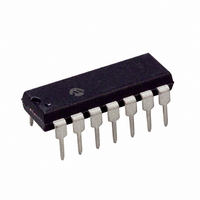PIC16F688-I/P Microchip Technology, PIC16F688-I/P Datasheet - Page 121

PIC16F688-I/P
Manufacturer Part Number
PIC16F688-I/P
Description
IC PIC MCU FLASH 4KX14 14DIP
Manufacturer
Microchip Technology
Series
PIC® 16Fr
Datasheets
1.PIC16F616T-ISL.pdf
(8 pages)
2.PIC16F688T-ISL.pdf
(204 pages)
3.PIC16F688T-ISL.pdf
(6 pages)
4.PIC16F688T-ISL.pdf
(4 pages)
5.PIC16F688T-ISL.pdf
(688 pages)
6.PIC16F688-EP.pdf
(174 pages)
Specifications of PIC16F688-I/P
Program Memory Type
FLASH
Program Memory Size
7KB (4K x 14)
Package / Case
14-DIP (0.300", 7.62mm)
Core Processor
PIC
Core Size
8-Bit
Speed
20MHz
Connectivity
UART/USART
Peripherals
Brown-out Detect/Reset, POR, WDT
Number Of I /o
12
Eeprom Size
256 x 8
Ram Size
256 x 8
Voltage - Supply (vcc/vdd)
2 V ~ 5.5 V
Data Converters
A/D 8x10b
Oscillator Type
Internal
Operating Temperature
-40°C ~ 85°C
Processor Series
PIC16F
Core
PIC
Data Bus Width
8 bit
Data Ram Size
256 B
Interface Type
SCI/USART
Maximum Clock Frequency
20 MHz
Number Of Programmable I/os
12
Number Of Timers
2
Operating Supply Voltage
2 V to 5.5 V
Maximum Operating Temperature
+ 85 C
Mounting Style
Through Hole
3rd Party Development Tools
52715-96, 52716-328, 52717-734
Development Tools By Supplier
PG164130, DV164035, DV244005, DV164005, PG164120, ICE2000, DM163014, DM164120-4
Minimum Operating Temperature
- 40 C
On-chip Adc
8-ch x 10-bit
Data Rom Size
256 B
Height
3.3 mm
Length
19.05 mm
Supply Voltage (max)
5.5 V
Supply Voltage (min)
2 V
Width
6.35 mm
Lead Free Status / RoHS Status
Lead free / RoHS Compliant
For Use With
AC162066 - HEADER INTRFC MPLAB ICD2 20PINAC162061 - HEADER INTRFC MPLAB ICD2 20PINDM163029 - BOARD PICDEM FOR MECHATRONICSAC162056 - HEADER INTERFACE ICD2 16F688ACICE0207 - MPLABICE 14P 300 MIL ADAPTERAC124001 - MODULE SKT PROMATEII 8DIP/SOIC
Lead Free Status / Rohs Status
Lead free / RoHS Compliant
Available stocks
Company
Part Number
Manufacturer
Quantity
Price
Company:
Part Number:
PIC16F688-I/P
Manufacturer:
MICROCHIP
Quantity:
26
Company:
Part Number:
PIC16F688-I/P
Manufacturer:
MOT
Quantity:
61
11.3
The PIC16F688 has multiple sources of interrupt:
• External Interrupt RA2/INT
• TMR0 Overflow Interrupt
• PORTA Change Interrupts
• 2 Comparator Interrupts
• A/D Interrupt
• Timer1 Overflow Interrupt
• EEPROM Data Write Interrupt
• Fail-Safe Clock Monitor Interrupt
• EUSART Receive and Transmit interrupts
The Interrupt Control (INTCON) register and Peripheral
Interrupt Request 1 (PIR1) register record individual
interrupt requests in flag bits. The INTCON register
also has individual and global interrupt enable bits.
A Global Interrupt Enable bit, GIE bit of the INTCON
register, enables (if set) all unmasked interrupts, or dis-
ables (if cleared) all interrupts. Individual interrupts can
be disabled through their corresponding enable bits in
the INTCON register and PIE1 register. GIE is cleared
on Reset.
The Return from Interrupt instruction, RETFIE, exits
the interrupt routine, as well as sets the GIE bit, which
re-enables unmasked interrupts.
The following interrupt flags are contained in the
INTCON register:
• INT Pin Interrupt
• PORTA Change Interrupt
• TMR0 Overflow Interrupt
The peripheral interrupt flags are contained in the
special register, PIR1. The corresponding interrupt
enable bit is contained in special register, PIE1.
The following interrupt flags are contained in the PIR1
register:
• EEPROM Data Write Interrupt
• A/D Interrupt
• EUSART Receive and Transmit Interrupts
• 2 Comparator Interrupts
• Timer1 Overflow Interrupt
• Fail-Safe Clock Monitor Interrupt
When an interrupt is serviced:
• The GIE is cleared to disable any further interrupt.
• The return address is pushed onto the stack.
• The PC is loaded with 0004h.
© 2009 Microchip Technology Inc.
Interrupts
For external interrupt events, such as the INT pin or
PORTA change interrupt, the interrupt latency will be
three or four instruction cycles. The exact latency
depends upon when the interrupt event occurs (see
Figure 11-8). The latency is the same for one or
two-cycle instructions. Once in the Interrupt Service
Routine, the source(s) of the interrupt can be
determined by polling the interrupt flag bits. The
interrupt flag bit(s) must be cleared in software before
re-enabling interrupts to avoid multiple interrupt
requests.
For additional information on Timer1, A/D or data
EEPROM modules, refer to the respective peripheral
section.
Note 1: Individual interrupt flag bits are set,
2: When an instruction that clears the GIE
regardless
corresponding mask bit or the GIE bit.
bit is executed, any interrupts that were
pending for execution in the next cycle
are ignored. The interrupts, which were
ignored, are still pending to be serviced
when the GIE bit is set again.
of
PIC16F688
the
DS41203E-page 119
status
of
their















